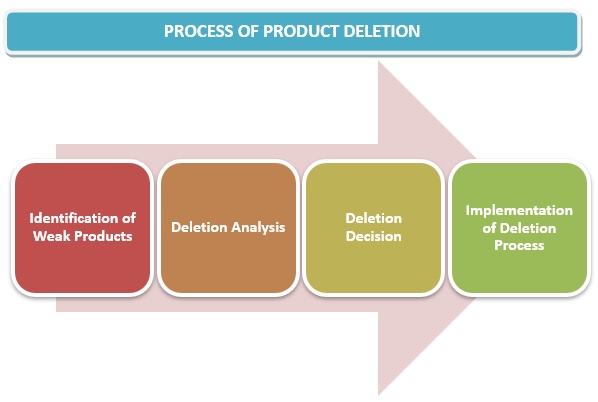- Business Concepts ›
- Marketing and Strategy ›
- Product Deletion
Product Deletion
Definition, Importance, Stages & Example
This article covers meaning & overview of Product Deletion from marketing perspective.
What is meant by Product Deletion?
Product deletion is the process through which a product or an entire product line is removed from the product portfolio either through product elimination or product replacement. Usually, product deletion is done when a product reaches the decline or death stage of the product life cycle or there is a dramatic decline in its sales and profits. A failing product reduces the profitability of the firm and results in draining of resources. This process of product deletion requires the company to evaluate its entire product mix and analyze where can the resourced be used to generate more reliable revenue streams.
Along with declining sales, there are several factors which contribute to product deletion including the firm's business model, failure of alignment with marketing strategies, local preference and culture, political and government rules and regulations, legal constraints and product malfunction. Product deletion or product elimination is a complex process. It involves communication with customers, proper production planning, evaluation of contracts etc.
Product Deletion Stages
Product deletion has four distinct stages:
1. Identification of products to be deleted.
2. Analysis of products to be deleted.
3. The decision to remove the product
4. Implementation of the deletion process

Importance of Product Deletion
If a product is not at a proper position in the market and not generating enough revenue, then all the resources invested in it are washed out which could have been used for the production of some other product or enhance some existing product. This calls for product deletion. Sometimes, there is a presence of a lot of products in the product line which leads to increased use of capital and resources being distributed too thinly. In these cases, the deletion of some products is essential. A weak product demands more managerial efforts with respect to different marketing decisions and may also lead to debilitation of the company's image and dissatisfaction of its shareholders. As the taste and preference of consumers change, there arises a need of deleting some products which no longer appeal to the new preferences. The old products can be totally eliminated by product deletion or replaced with some other new products. Sometimes, products which do not align with the current objectives of the company face deletion. Sometimes, when there are a lot of products in a product line, it leads to product cannibalism in which some products take away the business of some other products. It calls for product deletion of some products and thinning the product line depth.
Difference Between Product Deletion & Brand Deletion
Some firms market an array of several brands. For example, General Motors owns brands like Buick, Chevrolet, Cadillac, GMC, Holden, and Wuling. Sometimes, firms decide to discontinue some brands from their brand portfolio which is known as Brand Deletion. It involves the elimination of all the products under that brand name from the market. Taking the case of General Motors, a number of brands have been killed from the market like Hummer, Pontiac and Saturn and some brands like Saab, Vauxhall or Opel have been sold to other firms which are commonly termed as Brand Disposal.
Every brand has several products which constitute its product mix. For example, P&G owns several brands like Ambi Pur, Ariel, Gillette, Head & Shoulders, and Olay. Every brand, in turn, has a product line. For instance, Under the brand name of Ariel, there are several products like Ariel Matic Concentrated Liquid, Ariel Matic Front Load Washing Powder, Ariel Perfect Wash Washing Powder, and Ariel Matic Top Load Washing Powder. If Ariel decides to discontinue one or more products from its product line, then it will be called a Product Deletion.
Examples of Brand Deletion
Some examples of product deletion by companies are:
1. To compete with Pepsi Vanilla, Coca- Cola launched its own variant known as Coca- Cola Vanilla in the early 2000s. But the product did not appeal to the customers and due to low sales, it was completely phased out by 2005.
2. Hewlett Packard released its TouchPad with a robust processor and stirring video capability with the anticipation of giving Apple's iPad a run for its money. But the product was a colossal failure due to a flaw in its operating system and was discontinued immediately by product deletion.
3. P&G in an attempt to reposition its brand as a natural and organic brand released its "Touch of Yogurt' shampoo in 1979. However, customers failed to associate dairy with a hair product. Another shampoo 'Look of Buttermilk' also faced similar problems and both the products sold poorly. They are no longer available in the market.
Hence, this concludes the definition of Product Deletion along with its overview.
This article has been researched & authored by the Business Concepts Team which comprises of MBA students, management professionals, and industry experts. It has been reviewed & published by the MBA Skool Team. The content on MBA Skool has been created for educational & academic purpose only.
Browse the definition and meaning of more similar terms. The Management Dictionary covers over 1800 business concepts from 5 categories.
Continue Reading:
What is MBA Skool?About Us
MBA Skool is a Knowledge Resource for Management Students, Aspirants & Professionals.
Business Courses
Quizzes & Skills
Quizzes test your expertise in business and Skill tests evaluate your management traits
Related Content
All Business Sections
Write for Us